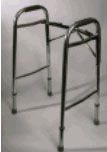Assistive Devices
There are a variety of assistive devices that can improve gait, steady balance, provide extra support and stability, and avoid fatigue from overexertion.
Canes
Canes can support up to 25 percent of your weight. The standard cane has single shaft, with a curved or flat top. The quad cane is a one-armed cane with four legs. Quad canes offer varying amounts of support, depending on the width of the leg base. While this cane is more stable than standard canes for balance, it is hard to use in narrow places, like a stair step. A doctor or a physical therapist is helpful in selecting an appropriate cane and providing instructions on how to use it.
Editor’s Note: One of our community members provided an article the process of adopting the use of a cane. See Patient Forum – cane.
Walker

A walker can support up to 50 percent of your weight. The standard walker consists of four adjustable legs and handgrips for each hand and is moved by picking it up and placing the legs flat on the ground one step at a time. The legs of the walker should be adjusted so that the handgrips are level with one’s hip.
To use a walker, you need adequate upper-arm strength, a reasonable amount of standing balance, and the ability to walk in the appropriate sequence with the walker.
Walker with Wheels
A walker with front wheels and rear brakes (rollator) may be preferable for someone who has balance problems, fatigues quickly, or doesn’t have enough upper-body strength to use a standard walker. This walker is moved by pushing it forward as the rear legs drag along the floor. It is stopped by pushing down on the back legs. It requires that the user have some degree of control to prevent the walker from rolling too far forward. It can be difficult to move on thick carpets.
Walker with a Seat
This walker can support up to 300 pounds and includes a strap to secure the person sitting on it. A walker with a seat has front wheels and rear brakes and works in the same manner as the walker above.
Wheelchairs
Wheelchairs come in a variety of sizes, designs, and materials. It is essential that a wheelchair fits properly, is comfortable, and meets one’s general functioning needs. If it is not the appropriate type or fit, a wheelchair may impair rather than aid in mobility.
Our Impact since our inception...
-
Dollars Raised
Over 11,000,000 dollars for research!
